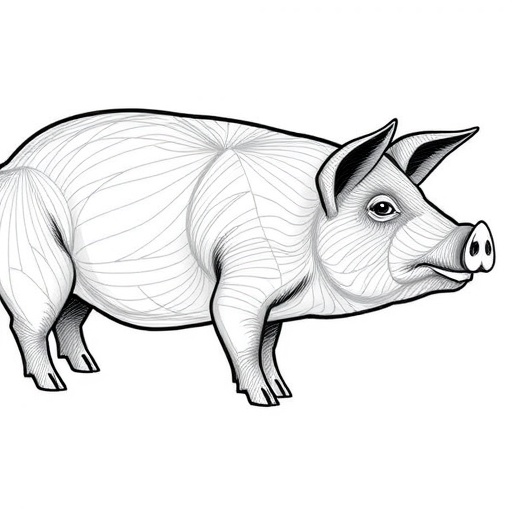In a groundbreaking study published in BMC Genomics, researchers have revealed the pivotal role of N6-methyladenosine (m6A) in enhancing the quality of porcine longissimus dorsi muscle—an essential component in the meat industry. The formation and differentiation of muscle fibers critically determine the quality of meat, affecting texture, tenderness, and overall taste. This research opens new avenues in agricultural biotechnology and genetics, shedding light on how manipulating epitranscriptomic markers such as m6A can lead to improved livestock.
Understanding m6A is critical to comprehending its effects on muscle development. This particular RNA modification has been implicated in various biological processes, yet its specific role in regulating myofiber differentiation was underexplored until now. The study conducted by a team consisting of Yin, Yang, and Huang et al. dives into the molecular mechanics behind how m6A modification enhances not only muscle quality but also yields within porcine species.
At the molecular level, m6A modifications affect RNA stability, translation, and degradation. The authors employed advanced genomic techniques to investigate how these alterations influence myofiber differentiation during muscle development. By assessing various RNA profiles and modifications within the muscle tissues, they established a robust correlation between m6A levels and improved muscle characteristics.
One of the most compelling aspects of this study is the demonstration of how m6A affects the differentiation of muscle satellite cells. Satellite cells are responsible for muscle growth and regeneration and play a crucial role in myogenesis. The researchers found that the presence of m6A enhances the proliferation of these cells, which in turn supports the formation of mature muscle fibers essential for high-quality meat production.
The research team also delved into the signaling pathways influenced by m6A modifications. They identified key regulatory proteins and enzymes that are upregulated in the presence of m6A, notably those involved in muscle homeostasis and development. The interplay between m6A and these pathways underlies the biological mechanisms responsible for the observed improvements in muscle fiber differentiation.
Moreover, the findings suggest practical applications in livestock breeding programs. By leveraging the insights derived from this study, animal breeders could select for genetic variants that promote higher m6A levels in muscle tissue. This not only paves the way for enhanced meat quality but also contributes to better meat production efficiency—an increasingly vital factor in meeting global food demands.
In the broader context of agricultural science, this research underscores the importance of epitranscriptomics—the study of RNA modifications—as a novel frontier in genetic and genomic research. Researchers are increasingly acknowledging that RNA modifications can have profound effects on phenotypes, and this study exemplifies how focusing on these mechanisms can lead to significant advancements in animal husbandry.
The implications of enhancing pork quality through m6A regulation extend beyond production efficiency. Consumers today are more informed and concerned about the quality of the meat they consume. The ability to improve tenderness, flavor, and overall quality through targeted genetic modifications can lead to higher consumer satisfaction and increased market demand.
As with any innovative research, there are challenges and limitations to consider. The authors stress the need for further studies to understand the long-term impacts of m6A modification on muscle physiology and animal health. Unintended consequences could arise if m6A regulation is modified too drastically or if other critical processes are inadvertently affected.
Ethical considerations surrounding genetic modification in agriculture cannot be overlooked. As this research and similar efforts progress, engaging stakeholders, including farmers, consumers, and policymakers, will be vital. Transparent communication about the processes, benefits, and potential risks involved in applying this science will become increasingly important in garnering public support and acceptance.
Ultimately, the journey of this research—from the lab to practical applications—reveals the breathtaking possibilities that modern science can bring to traditional industries. By merging genomic science with agricultural practices, we can begin to reshape the future of livestock production. The study serves as a groundbreaking step towards a more sustainable, efficient, and quality-driven approach in farming.
The findings of Yin, Yang, Huang et al. do not only represent a traditional scientific contribution; they represent a paradigm shift in how we can leverage molecular biology to inform agricultural methodologies. In the coming years, we can expect to see the ramifications of this study ripple through the meat industry, influencing practices and product offerings.
As interest in alternative proteins and sustainable farming practices continues to grow, studies like these are essential in ensuring that traditional livestock remains competitive. By improving muscle quality and optimizing production, the agricultural sector can better align with the future trajectory of consumer preferences and environmental sustainability goals.
Research efforts aimed at unraveling the complexities of muscle fiber differentiation open a full spectrum of possibilities for not just porcine species, but also broader livestock and poultry industries. In each fiber, there’s an opportunity for innovation and improvement waiting to be unlocked with ongoing and future research endeavors focused on genetic and epitranscriptomic approaches.
As we look ahead, this research may spark inspiration in various disciplines, promoting interdisciplinary collaboration that combines faculty and expertise in biotechnology, genetics, epitranscriptomics, and animal sciences. How far we progress with these insights and innovations will depend significantly on continued investment in research and developmental frameworks aimed at better understanding muscle biology at the molecular level.
In conclusion, the investigation by Yin et al. marks a significant contribution to agricultural science, emphasizing the potential of molecular modifications to revolutionize meat production. As technology advances, let us remain committed to utilizing science responsibly, ensuring that enhancements in livestock quality not only benefit producers but also meet the increasingly sophisticated preferences of consumers around the world.
Subject of Research: Enhancing porcine muscle quality through N6-methyladenosine regulation.
Article Title: N6-methyladenosine improves porcine longissimus dorsi muscle quality by regulating myofiber differentiation.
Article References:
Yin, C., Yang, S., Huang, Y. et al. N6-methyladenosine improves porcine longissimus dorsi muscle quality by regulating myofiber differentiation.
BMC Genomics 26, 850 (2025). https://doi.org/10.1186/s12864-025-12063-1
Image Credits: AI Generated
DOI: 10.1186/s12864-025-12063-1
Keywords: N6-methyladenosine, porcine, longissimus dorsi, muscle quality, myofiber differentiation, epitranscriptomics, livestock production, genetic modification.




